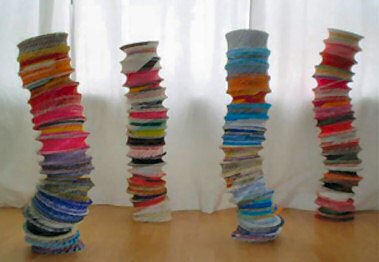Martine Horstman
 The starting-point for her visual work is to make a strong, movable and challenging construction with paper. Horstman worked with paper in a previous project and discovered a number of characteristics of paper. She started experimenting with different constructions and techniques of paper processing. The paper should have a certain strength and stiffness to achieve the desired effect. Her choice for Boomerang cards emanates from this. The postcards, available in cafés, cinemas and schools, have the right thickness of paper for a strong construction. Cutting the cards and folding them in a harmonica shape creates spaces between the cards. Martine Horstman’s objects can be interpreted in several ways. They can be seen as an autonomous statue or as a piece of jewelry.
The starting-point for her visual work is to make a strong, movable and challenging construction with paper. Horstman worked with paper in a previous project and discovered a number of characteristics of paper. She started experimenting with different constructions and techniques of paper processing. The paper should have a certain strength and stiffness to achieve the desired effect. Her choice for Boomerang cards emanates from this. The postcards, available in cafés, cinemas and schools, have the right thickness of paper for a strong construction. Cutting the cards and folding them in a harmonica shape creates spaces between the cards. Martine Horstman’s objects can be interpreted in several ways. They can be seen as an autonomous statue or as a piece of jewelry.
Spirally (2002), Material: Boomerang cards.









